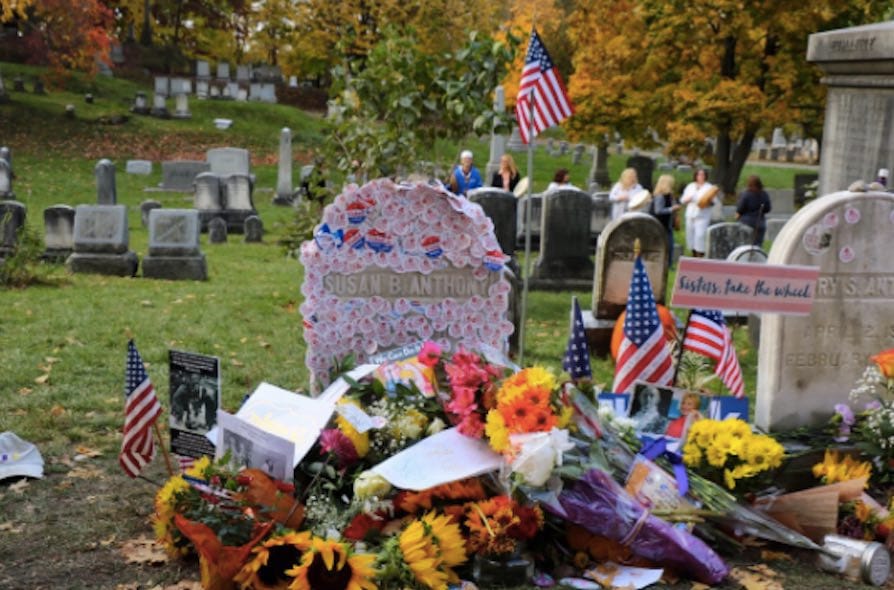From Susan B. Anthony To Hillary Clinton — Women’s Historic Fight For Representation


Today marks the first time in American history that voters have the chance to vote for a woman from a major political party to become President of the United States. Whether you support Hillary Clinton, whose national campaign headquarters are in Brooklyn, or not, the gravity of history being made today cannot be denied.
There are women voting today who were alive when women weren’t allowed to vote. On WNYC’s Brian Lehrer Show this morning, countless callers described the emotions of dedicating their vote to ancestors who wouldn’t believe this glass ceiling was finally shattered.
Because of the intrepid work by New Yorkers like Susan B. Anthony and Congresswoman Shirley Chisholm, who in 1972 was the first woman to seek the Democratic presidential nomination, a path was paved that allowed little girls across this nation to dream about one day staking their claim in the oval office.
We took a brief look at the historic events of the early 20th century that helped set the stage for today.
Amazing sight here at Susan B. Anthony gravesite in @rochester#ElectionDaypic.twitter.com/jm9iMYHU55
— John Kucko (@john_kucko) November 8, 2016
Women in New York State had actually won the right to vote in local elections in 1917.

After a decades-long battle, Congress passed the 19th amendment on June 4th, 1919, giving all American women the right to vote.
“The [19th] amendment holds the record of being before the country longer than any successful amendment to the Constitution,” the Daily Eagle stated in 1920. It was first introduced in Congress in 1878, after being drafted by Susan B. Anthony and Elizabeth Cady Stanton, both of New York.
You can learn more about Anthony and her triumphant work for women’s equality at the Brooklyn Museum’s Elizabeth A. Sackler Center for Feminist Art exhibition.
Wisconsin and Michigan were the first states to ratify the 19th amendment, the Daily Eagle reported, “quickly followed by New York, Kansas and Ohio.”
Tennessee was the last state to ratify, and the margin in the Tennessee state legislature was razor thin, as you can see from the headline in the Daily Eagle clipping at the top of this story.
The 19th amendment was finally ratified by three-fourths of the states on August 18th, 1920. Ratification gave 27 million women the right to vote, an article in the Brooklyn Daily Eagle reported on the day.
Not everyone supported women’s suffrage. In a letter to the editor of the Daily Eagle on January 29, 1922, George Stuart Brown (of 15 Clark Street in Brooklyn Heights) had this to say:
“If it is legal to coerce the suffrage of the people of a State, it will be legal for outsiders to destroy a State’s property system or marriage system or any other local State institution…
If the 19th amendment is legal, the people have ceased to be sovereign. Their sovereignty has been transferred to their omnipotent amending agents.”
Historic Presidential Election in 1920
Less than three months after getting the vote, American women headed to the polls to vote for president. The candidates in 1920 were Republican Warren G. Harding of Ohio; Democrat James M. Cox, also of Ohio; and Socialist Eugene V. Debs of Indiana, reports History.com.
Incredibly, Debs was running from prison. He had been convicted of sedition in 1918 after a speech opposing American involvement in World War I.
Warren Harding’s running-mate in 1920 was Calvin Coolidge. Running with Democrat James Cox was none other than New Yorker Franklin Roosevelt.
In 1920, the Republican party was recovering from a “generation of progressive insurgency,” notes History.com, and was calling for a “return to normalcy.” World War I had ended only two years before.
Republican Warren Harding won the presidency in 1920 by a large margin — with 16 million popular votes compared to Cox’s 9 million.
Although still in prison, Socialist Eugene Debs received more than 900,000 votes. We are guessing at least a few Brooklyn women voted for Debs.
Sean Egan co-wrote this story.




